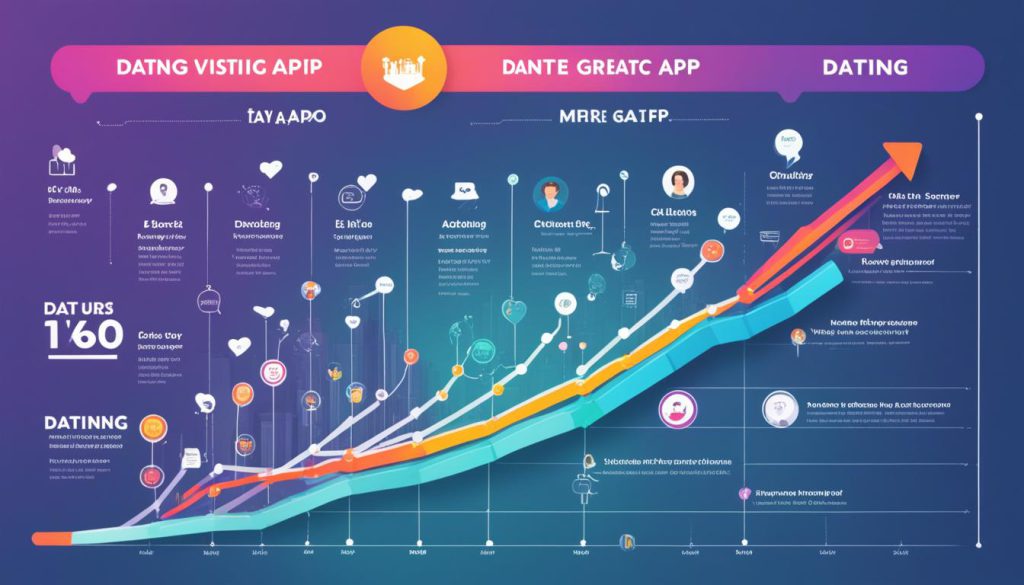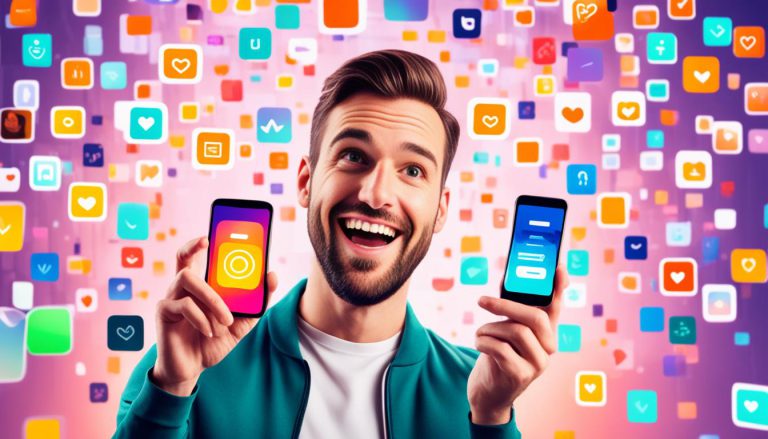In today’s world, almost half of Americans believe dating apps are the best way to find love. It makes me wonder. Are we getting better at love, or are we losing true connection by swiping? The world of online dating keeps changing. As someone who’s been through it, I’ve seen how new trends shape the way we date. It seems every update in dating apps might help us meet ‘the one.’
Key Takeaways
- Online dating apps are considered the top spot for meeting dates, with 45% of Americans in agreement.
- The 18-58 age group predominantly uses dating apps, showcasing the digital trend’s broad appeal.
- While swiping for love, users tend to prize both looks and personality, balancing the two equally at 50% when arranging that critical first date.
- Love-related timelines are shifting, with nearly 29.4% believing in expressing love within four to six months of dating.
- A surprising 42.3% view romantic dreams about others as a form of infidelity, indicating nuanced standards in online courtship.
- Eventbrite’s boost in speed dating events and singles attendance marks a resurgence in traditional dating practices.
- The intriguing rise in AI’s role in dating, from profile crafting to first messages, hints at a tech-infused future in romance.
Emerging Features in Popular Dating Apps
I’ve been keeping an eye on how dating apps change and grow. Dating app features are getting more personalized to meet different needs. This shows apps now focus more on giving users what they really want.
Gen-Z users, though a smaller part of the scene, are shaping how dating apps work. They like connecting through social media sites like Instagram and TikTok. To match this trend, app makers are designing new features in dating apps for more natural interactions.
Millennials are seeing apps like Bumble and Hinge create ways for deeper ties. These changes help create more exclusive relationships from app interactions. The growth of Bumble and the success of Hinge show a move towards apps that support serious connections.
Money is getting more attention in the dating app world. With big revenue rolling in—$5.34 billion in 2022—it’s clear people don’t mind paying for special features. Even so, many younger users prefer not to spend a lot on dates, pointing to a demand for cost-friendly app features.
Many are single, and the average age for first marriage is climbing. This means more people are looking for something lasting. Apps are responding by helping users find long-term partners. It seems that many who meet on apps end up in committed relationships.
Self-care is huge for 18 to 25-year-olds in the dating scene. A big majority put this first in their lives and want partners who feel the same. This is leading to dating app features that support both companionship and self-care.
The changes in the dating app market suggest that apps that cater to these new ways of living will keep users around longer. Despite many deleting apps quickly, those that really connect with users’ lives will stay in the game.
In wrapping up, seeing how the industry is quickly adapting to what users need is heartening. From accepting different types of relationships to valuing health, apps are evolving fast. I’m eager to see how technology will continue to refine our romantic experiences.
Dating App User Behavior Insights

In my time covering online dating’s changes, I’ve observed technology’s big impact on user behaviors and preferences. Almost 30% of U.S. adults use dating services, a number that grows among those under 30. This has led to cool innovations in user interfaces. These ensure the diverse needs of users are met.
Consumer Attitudes Toward Dating and Technology
Among my peers and other users, feelings about online dating are more positive. Looking at the data, 44% of app users want long-term relationships, showing a serious quest for love. Further, 70% of connections via apps lead to exclusive relationships, especially for adults aged 43 to 58. This shows that actions, indeed, speak louder than words.
How Users Are Balancing Personality and Appearance in Profiles
The challenge of balancing personality with looks is tricky. About 31% of people put personality first before a first date. This shows a strong desire for real connections over looks. Still, 54% of women feel swamped by messages, and 64% of men feel insecure about getting fewer. This highlights the struggle between presenting oneself and meeting others’ expectations.
The Rise of Dating App Fatigue and User Retention Strategies
Despite the excitement over these platforms, “dating app fatigue” is real. It proves that innovation is key in keeping users engaged. Services need to be more than just matchmaking; they should support ongoing engagement. Since over a third of Bumble users have recently left significant others, apps need to offer more. Emotional maturity is now more important than looks for 63% of users, marking a shift in dating dynamics.
| User Preferences | Percentage Seeking | Notable Trends |
|---|---|---|
| Long-Term Partnership | 44% | Preference for personality over looks |
| Positive Dating Experience | 53% | Positive sentiment towards dating apps |
| Exclusive Relationships | 70% (meeting through apps) | Bias toward emotional over physical cheating |
| Emphasis on Personality | 31% (before first date) | Shift towards emotional maturity |
| Non-monogamous Relationships | 34% | Primarily under 45 demographic |
Looking at the innovations and demographic focus, the evolution of dating app behavior is intriguing. Watching the story of romance evolve through technology is captivating, and I’m excited to see where it leads.
Dating App Statistics: A Demographic Breakdown
When looking at dating app statistics, we see a diverse user group. In the U.S., 30% of adults have tried dating sites or apps. Remarkably, 9% ventured into online dating in the last year. The data shows a bias towards younger people, with 53% of those under 30 dipping their toes into digital dating.
Exploring further, we see different age groups engaging differently. Among 30-49-year-olds, 37% have used these platforms. This number drops to 20% for those aged 50-64 and to 13% for those 65 and over. So, interest varies with age but doesn’t disappear.
The platforms serve various communities uniquely. For instance, 51% of LGB adults use dating apps versus 28% of their straight counterparts. Also, more men (34%) than women (27%) have explored online dating. This shows how these platforms play a vital role in diverse dating scenarios.
Some apps draw more users. Tinder leads with 46% of users, followed by Match with 31%, and Bumble with 28%. These figures highlight user preferences and the diversity of these dating services.
About the outcomes, 10% of partnered adults met their match online. Moreover, 53% of users report positive experiences, with men (57%) and LGB users (61%) leading. This underlines the effectiveness of online dating.
In the realm of paid versus free options, 35% have paid for extra features. Also, users seek various things: 44% want long-term relationships, while 40% are into casual dating. This variety shows people’s different needs in dating apps.
| Intentions | Percentage |
|---|---|
| Long-term Partner Seeking | 44% |
| Casual Dating | 40% |
Looking at online dating’s impact, 42% believe it simplifies finding a long-term partner; 22% disagree. On the choice abundance, 43% found it just right, but 37% felt overwhelmed. These statistics paint a comprehensive picture of the online dating landscape.
My journey into the demographic breakdown in dating apps has been eye-opening. It makes me wonder how these platforms will further evolve to meet our connection needs.
Dating App Trends
The way we look for love has changed with new tech. In 2024, AI and machine learning are big in dating apps. They make better matches. Now, 53% of young people use dating sites or apps. It shows they want smart connections.
Adoption of AI and Machine Learning for Better Matches
AI is ending the days of endless profile browsing. Now, apps give personalized match ideas. 42% of U.S. adults think dating apps help find serious partners.
The Impact of Subscription Models on User Experience
Subscription models change how dating sites make money. 35% of users pay for better matches. They’re willing to spend on their love life.
Gamification: The New Frontier in User Engagement
Gamification makes dating fun and engaging. It turns finding love into a game. 22% use apps to meet friends. Games add to the fun.
| Demographic | Ever Used Dating Sites/Apps | Used in Past Year |
|---|---|---|
| U.S. Adults (Total) | 30% | 9% |
| Under 30 | 53% | – |
| 65 and Older | 13% | – |
| LGB Adults | 51% | – |
| Straight Adults | 28% | – |
Looking at these changes, it’s exciting. We are moving towards a world where finding love is easy. Thanks to new trends, love is just a swipe or an algorithm away.
Conclusion
Looking at today’s popular dating apps, I see how my experiences align with the larger trends in online dating. Apps like OkCupid and Tinder have grown, becoming key for those seeking connections. Knowing that 35 percent of online daters get unsought explicit messages has led me to prefer safer platforms.
Reflecting on my time using dating apps, especially after hearing Abby’s story, has been eye-opening. She’s a long-term user thinking of switching to a matchmaker due to digital disappointments. Learning that nearly 37 percent of online daters have been contacted against their will makes me think. Still, the 10th anniversary of Tinder sparks a debate on its influence on dating culture and our emotional health.
It seems education affects views on online dating’s impact, with 30 percent of degree-holders seeing it positively, versus 18 percent of those less educated. Yet, over half of Americans believe online relationships can be just as strong as those started in person. I remain cautiously optimistic about online dating. I know I’m not alone in my mixed feelings about searching for love online. As we move through these digital spaces, we see how technology has forever changed dating, yet it has also broadened our opportunities for finding connection.
Source Links
- https://www.forbes.com/health/dating/state-of-dating/
- https://www.npr.org/2024/02/14/1230979304/speed-dating-ai-online-living-apart-together-trends-relationships
- https://time.com/6836033/gen-z-ditching-dating-apps/
- https://www.businessofapps.com/data/dating-app-market/
- https://www.forbes.com/health/dating/dating-statistics/
- https://www.pewresearch.org/short-reads/2023/02/02/key-findings-about-online-dating-in-the-u-s/
- https://www.ncbi.nlm.nih.gov/pmc/articles/PMC10132638/
- https://www.nytimes.com/2022/08/31/well/mind/burnout-online-dating-apps.html
- https://www.pewresearch.org/internet/2020/02/06/americans-opinions-about-the-online-dating-environment/

